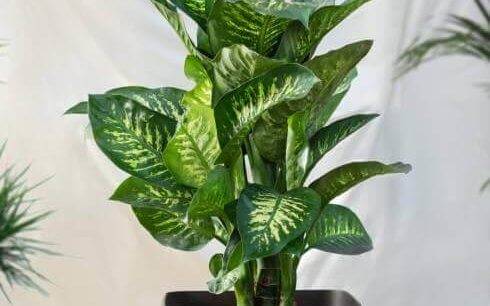Dieffenbachia Care in Winters: How to protect Dieffenbachia(Dumb Cane Plant) from Extreme Cold?
Dieffenbachia is a perfect houseplant as it is a really elegant-looking plant, with easy to grow, best indoor plant qualities. The plant is also known as a dumb cane due to its toxic juice in leaves or stems if ingested can cause temporary numbness or dumbness. Though it is a showy plant, it has many more good features than this. In this article, you can know about Dieffenbachia Care in Winters: How to protect Dieffenbachia(Dumb Cane Plant) from Extreme Cold?
Quick takeaways:
- To grow Dieffenbachia you need 65-75 degrees Fahrenheit temperature.
- The different ways to protect the plants in water are Sunlight, Watering, Soil, and Fertilize.
| Common Names | Dieffenbachia, dumb cane |
| Botanical Name | Dieffenbachia spp. |
| Family | Araceae |
| Plant Type | Herbaceous, perennial |
| Mature Size | 3–10 ft. tall, 2–3 ft. wide |
| Sun Exposure | Partial |
| Soil Type | Well-drained |
| Soil pH | Acidic |
| Bloom Time | Spring, summer |
| Flower Color | White |
| Hardiness Zones | 10–12 (USDA) |
| Native Area | Caribbean, South America |
| Toxicity | Toxic to people, pets2 |
How to care for Dieffenbachia in winter? – Dieffenbachia Care in Winters
Dieffenbachia has no trouble growing indoors until the temperature is not too low or too high. The Dieffenbachia gets badly affected by winters. The plant needs 65-75 degrees Fahrenheit temperature. The dropping of temperature can still not affect much until it falls below 59 degrees Fahrenheit. Mostly the leaves and stems indicate the damage caused by varying temperatures. Usually, the falling of leaves is seen if the temperature goes to colder notes.
What to do to protect DIeffenbachia from winters?
Temperature: The dieffenbachia plant should be placed in a spot having a full sun to partial shade. The temperature is advised to stay above 60 degrees Fahrenheit. You can also avoid the excess heat or afternoon sun rays by simply using sun shades or sheets on the windows.
Sunlight: The indirect sunlight will keep the Dieffenbachia plant healthy. Also make sure to look around whether the stove, heater or anything else is not near to plants during winter. direct heat is not good for dum cane plants.
Watering: The plants don’t need excess watering but regularly. But in winter it is important to lower the watering of the plants. Avoid regular watering, instead, you can drizzle the plant leaves with water spray to make them wet and look extra shiny.
Soil: The soil shouldn’t be wet if you are watering. It is dry and appears light brown, then you can water care the plant in winter. If you transplant the dieffenbachia to a new pot, create a lot of drainage holes in the pot so that the soil doesn’t stay damp for long, as this might lead to fungal infection or rotting.

Fertilize: If you want to fertilize the dumb cane in winter, minimize it to a 2-3 weeks gap than in summers. If you see some brown spots on the leaves of dumb cane plants, stop fertilizing the plant further. Keep the soil moist but not too damp and soaked in water at such low temperatures.
For more such plant related-articles, you may also read, Crassula plants: Species, growth, care, propagation, pruning, and Benefits!
Dryness: The dryness of leaves can help the spider mites to attack and infect the Dieffenbachia plants. Make sure they stay moist.
How do you find out if Dieffenbachia is cold?

The yellowing of leaves occurs, and the lush green colors start to fade away. In many cases, the leaves of Dieffenbachia start to curl or look droopy. Frosting can cause the rotting of roots and stems in dumb cane plants.
Way to Repot Dieffenbachia:
Repotting the plant helps prevent root bounding and the development of dumb cane’s roots out of the container Which makes the root densely packed. the perfect time to repot the plant is during the springtime so that the plant gets the entire growing season for existing in a new environment. the following is the way to repot Dieffenbachia:
- First, you need to fill the new pot with well-draining soil that maintains the moisture properly. now you need to prune dead leaves from the plant.
- I would prefer you to dry out the old soil of the plant before transferring it so that the plant can easily slip out of the pot.
- after getting the old plant out of the pot you need to remove all the remaining soil and then raise the roots properly and it is a compulsory process.
- Make sure to check for the root rot condition and trim of if you find any root infected using a sterilized razor. now the plant is ready to plant in a new pot after placing the plant in the centre of the soil you need to cover this plant with the thin layer of moist in soil again.
Way of Propagating Dieffenbachia:
The following are some different ways to propagate Dieffenbachia:
Root Cutting:
If you want to propagate using the root stem first you need to sterilize a razor to make a cut in a section of roots from the parent plant. After cutting the root you need to place the plant again in the pot and mix the soil with some rooting hormone in it.
Stump Cutting:
For propagating the plant using stump cutting you need to grapes the plant nicely. cut the top of the older plant and then place the stem in the pot and mix with the rooting stem. you will observe new leaves growing from it after a few days.
Cane Cutting:
To complete the process of propagating doing cane cutting you need to cut a piece of the cane consisting of at least one bird on it with the help of a sterilized razor. then keep the piece of cane horizontally in the pot. if you want quick growth of the route you can use a combination of moistened potting mix and peat moss.
Common Issues with Dieffenbachia:
Dieffenbachia is a low-maintenance plant but it can have common problems if you don’t provide them suitable environment for growing.
Yellow Leaves:
In the case of turning leaves to yellow is a symptom of either underwatering or overwatering the plant. in case you want to water the plant you need to check by dipping the finger about to inch in the soil. if you feel the soil is not moist hold off on water until the soil is fully dry and if you find the soil is totally dry then you need to water the soil as soon as possible. make sure to cut off the yellow leaves whenever you find them in the plant. growing of yellow leaves is also a sign of malnutrition, in that case, you need to add fertilizer to the water in a routine so that they can get the nutrients to grow quickly. in case you find the leaves are turning Brown and crispy at the edge then it is a sign of over-fertilization.
Wilting or Drooping Leaves:
The leaves of the plant start wilting if they need more water and if the plant is suffering from root rot condition. In case if you find the soil is dry then it can be the symbol of Underwater but if this soil is wet but still the leaves are wilting then it could be due to any root infection.
dropping of the leaves of the plant is a symbol that the plant is getting too much sunlight full stop to get rid you need to relocate the plant to a part of the house. in case the plant is grouping yellow then it can be because the plant does not get a good amount of Sunlight.
Pests:
Spider-mites, mealy worms, and aphids are the pests that get attracted to the plant. In case you want to cure your plant from the pest you need to wash or Vibe the best using a pest control professional
Wrapping up the context:
Hope you like our effort to make you aware of winter protection for your dumb cane plants. Dieffenbachia Care in Winter is an important topic for this lovely houseplant. Houseplants like Dieffenbachia need extra care in the winter and now you have to understand everything about it. Happy planting and happy winters!
FAQ:
How do I save my Dieffenbachia plant?
Look for any stem rot or root rot that can be a result of overwatering. Make sure you keep the soil moist, but not drained in water. Water the plants only when needed, if the soil looks dry. Provide them an adequate amount of sunlight but prevent overdrying.
How do you care for an outdoor Dieffenbachia plant?
Dieffenbachia is an attractive houseplant with its wild patterns and color options. Though Dieffenbachia demands a lot of heat and sunlight, direct sunlight can damage it. Make sure you place it in a shady spot where the sunlight is adequate but is not direct.
Can Dieffenbachia grow outside?
Dieffenbachia can easily grow outside, they love heat and sun until sunlight is indirect. In cold areas, the spot having good sunlight would be perfect to make sure to provide shade during the noon sunlight. In warm areas, a shady area with warm and good sunlight is good for their growth.
What causes brown tips on Dieffenbachia leaves?
Tips of dumb cane plants are seen to be turning brown if they are being watered irregularly. You are required to water the plants regularly but not in excess. If the soil is still damp and the leaves look dry you can simply spray the leaves with water to make them look fresh, shiny, and moist.
Is Dieffenbachia an indoor or outdoor plant?
Until you are providing the Dieffenbachia plant indirect sunlight, it is good to be placed whether indoors or outdoors. The very low light will result in stunted growth of dumb cane plants, so choose a spot that is warm and have enough sunlight.
How long do Dieffenbachia plants live?
Depending upon the amount of care you are giving your dumb cane plants, they can grow for years if well-watered, refreshed well, and repotted. Otherwise, you can see them deteriorating dramatically. They achieve a height of 1.5-2 feet in just a year if maintained well.


